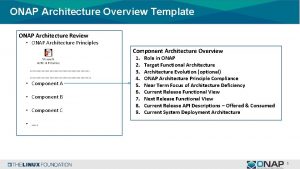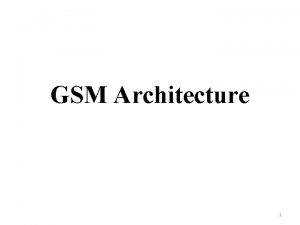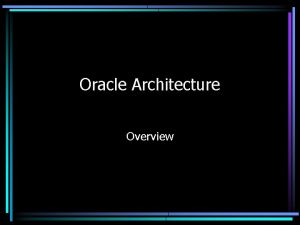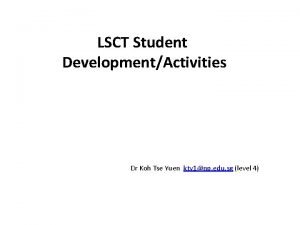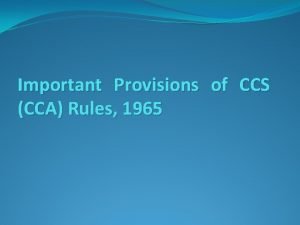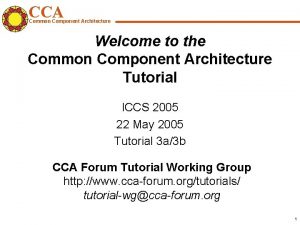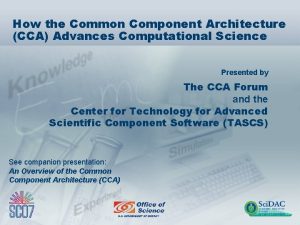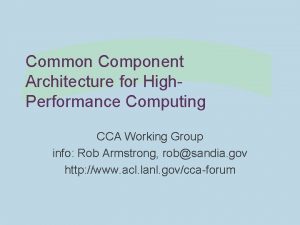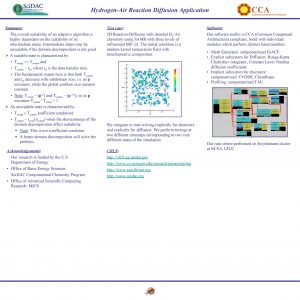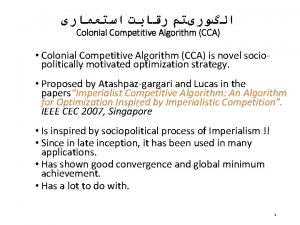An Overview of the Common Component Architecture CCA









- Slides: 9

An Overview of the Common Component Architecture (CCA) Presented by The CCA Forum and the Center for Technology for Advanced Scientific Component Software (TASCS) See companion presentation: How the Common Component Architecture Advances Computational Science

Motivation · Complexity of scientific software increases with simulation fidelity, multi-physics coupling, computer power software crisis · Component technology is well established outside of high-performance computing (HPC) as a way to manage software complexity - All enterprise software is component software, but commercial implementations do not support HPC · The Common Component Architecture (CCA) brings component software approach to scientific HPC - Grass-roots effort launched in 1998 2

Benefits to software developers · Components are natural units of decomposition and interaction for both software and developers - Manage software complexity · They enable scientists to work together as a cohesive scientific enterprise, across disciplines, geographical boundaries, and technical preferences by facilitating… - Collaboration around software development - Interoperability and reuse of software tools - Community standards for scientific software - Coupling of disparate codes CCA-based simulation of OH concentration in advective-diffusivereactive simulation using 4 th order Runge-Kutta. Chebyshev integrator on 4 levels of adaptively refined mesh Courtesy of J. Ray, Sandia National Laboratories 3

Basic CCA concepts · Components - Are units of software development/ functionality - Interact only through well-defined interfaces - Can be composed into applications based on their interfaces · Ports · Frameworks - Hold components while applications are assembled and executed - Control the connections of ports - Provide standard services to components - Are the interfaces through which components interact - Follow a provides/uses pattern · Provided ports are implemented by a component · Used ports are functionality a component needs to call 4 Screenshot of application in the Ccaffeine framework’s GUI

CCA features for scientific HPC · Parallel computing - Component mechanisms apply within a process - Parallelism across processes is up to each component · Usual tools: MPI, Global Arrays, PVM… - Both SPMD and MPMD supported · Distributed computing - Supported transparently to components · Performance - Components in same process share memory · Small overhead on inter-component calls - No overhead on parallel communication - Minimal language interoperability overhead · Language interoperability - Implementation language of component shouldn’t matter to others - Babel treats all supported languages as peers - SIDL allows language-neutral specification of interfaces 5 f 77 C f 90/95 C++ Pytho n Java

Current status of the CCA · CCA specification well established and stable - Approaching “ 1. 0” completeness · Suite of tools implement the CCA environment - Babel, Chasm (language interop), Ccaffeine (framework) - Other frameworks also available · CCA tools and concepts are used by more than 25 different application groups in diverse fields - CCA provides a common infrastructure for developing simulation toolkits and frameworks, coupling disparate codes, and many other types of applications - CCA benefits users in many different ways - See companion presentation How the Common Component Architecture Advances Computational Science 6

CCA research and development plans · Leverage the component environment to provide important new capabilities to software developers - Adapt running applications for performance, accuracy, faults, and other criteria - Improve software quality via software contracts, testing, and verification - Use high-end hardware with massive parallelism, heterogeneous processors · Mature the CCA environment and tools to production quality · Grow a “component ecosystem” - Enable plug-and-play application development using off-the-shelf scientific components · Help computational scientists effectively use component technology 7

The CCA community · The CCA Forum is the standards body and user group – Quarterly face-to-face meetings, mailing lists, collaboration resources 8 • DOE Sci. DAC-funded Center for Technology for Advanced Scientific Component (TASCS) Software core CCA development team • Many other projects and sponsors contribute to development and use of CCA

For more information · See companion presentation: How the Common Component Architecture Advances Computational Science · ORNL booth at SC 2006 - David E. Bernholdt, Wael R. Elwasif, James A. Kohl (ORNL) - Tom Epperly, Gary Kumfert (LLNL) - Rob Armstrong, Jaideep Ray (SNL) · Other booths at SC 2006 - Ames Laboratory (Booth 217) Indiana University (2214) NNSA/ASC (1217) Pacific Northwest National Laboratory (321) Tech-X Corporation (1149) University of Utah (1849) · On the internet - http: //www. cca-forum. org - cca-forum@cca-forum. org 99 Bernholdt_Overview_0611

